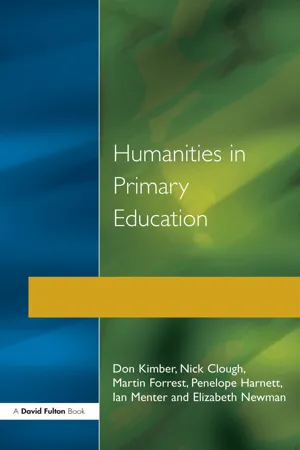
Humanities in Primary Education
History, Geography and Religious Education in the Classroom
- 203 pages
- English
- ePUB (mobile friendly)
- Available on iOS & Android
Humanities in Primary Education
History, Geography and Religious Education in the Classroom
About This Book
First Published in 1995. This innovative series is an ideal means of supporting professional practice in the post-Dearing era, when a new focus on the quality of teaching and learning is possible. The series promotes reflective teaching and active forms of pupil learning. The books explore the implications of these commitments for curriculum and curriculum-related issues. This book has emerged out of the collective experience of six colleagues who work together at the Faculty of Education of the University of the West of England, in Bristol. The twin strands here are a social constructivist model of learning and a reflective teaching model of pedagogy. Through reflecting on our experiences and evaluating their intentions, practices and outcomes, not only do we learn, but we also enrich the learning of those children, pupils and students with whom we are working.
Frequently asked questions
Information
Chapter One
Exploring Humanities in the Primary Curriculum
‘What is special about being human?’
‘The person that did something’
Teacher: Yes, you are nearly right. Right at the end there can you see where it says 43 and then 0. One thousand, nine hundred and ninety three years ago Jesus was born. Jesus lived in a land called…
Leonie: Jerusalem.
Teacher. You are very nearly right. Land of Palestine. Can you see? Have you got a map? This is the sea. You said Jerusalem. If we look there, that place is…can your read it?
Leonie: Jericho.
Teacher: Have you heard of the name?
Leonie: In the story.
Barry: North [looking at the map and pointing].
Teacher: Quite right – that’s North.
Eileen: The traveller – he got robbed.
Vincent: And punched and kicked.
Alison: They took his coat and money.
Brian: [interrupting or contributing before a formal invitation to speak] They did not have many signs and things.
Teacher: There weren’t any signs. Now can you see what sort of country that looks like in the picture. Can you see, Rachel?
Rachel: Is it all sand?
Teacher: It is all sand.
Rachel: It looks like all hills, and it’s bumpy, and sand on.
Teacher: Bumpy and sand. What do we call places which are very hot – very hot and very sandy, and little rain?
Brian: Erhm…
Teacher: Beginning with ‘D’. Do you know Benjamin?
Benjamin: Desert.
Teacher: Desert. Desert – good. Have you all heard of deserts?
Rachel and others: Yes.
Teacher: Part of Palestine was like this, other parts had large cities.
Brian: Priest.
Teacher: Yes – What does a priest do? What’s a priest’s job? Do you know, Tina?
Tina: To help people.
Teacher: Yes, they should help people, but then perhaps we should all help people.
Brian: I know.
Teacher: Tammy, what else does a priest do. Anything else?
Tammy: They go to church.
Teacher: They go to church, yes, anything else?
Mark: I – they tell people things in church.
Teacher: Yes, they tell people things in church, so a priest would have been in the Temple, or the Jewish synagogue and helping people know what to do to be right. The priest hurried on his way didn’t he?
Child: Yeh.
Teacher: …and left the man there.
Anthony: Really, if he was – erm – was not on his way to church he would have stopped going and helped him.
What is the nature of primary humanities?
Table of contents
- Cover
- Title
- Copyright
- Contents
- Introduction
- Chapter 1 Exploring Humanities in the Primary Curriculum
- Chapter 2 Roots and Traditions
- Chapter 3 People and Place
- Chapter 4 Stories, Values and the Challenges of Religious Education
- Chapter 5 Environmental Education
- Chapter 6 Education for Citizenship in a Changing World
- Chapter 7 European Dimensions
- Chapter 8 Staged Events and Experiential Learning
- Chapter 9 Humanities in the Primary Classroom – The Role of the Teacher
- Chapter 10 Conclusion
- Appendix: Council of Europe Memorandum on Teaching and Learning About Human Rights in Schools
- References
- Index